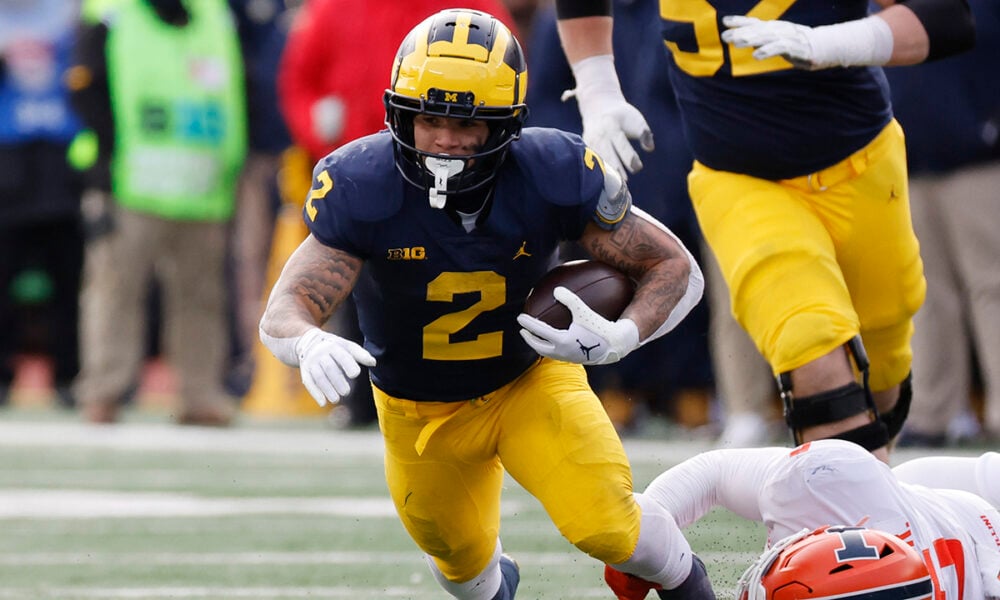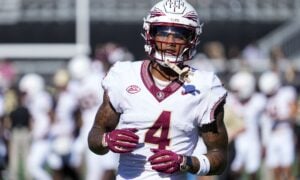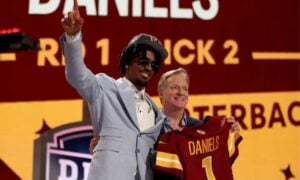Analysis of 2024 Rookie Running Backs By ADP: RBs 5-8

As we prepare for the NFL Draft, we now have had time to digest the Scouting Combine and pro day events, so what does the running back landscape look like in 2024? Unlike past years, where there were some clearcut top dogs in the draft, we are left guessing what GMs are thinking about this class.
This year the running back class might be more up in the air than any year I can remember in my last 15 years of playing dynasty fantasy football. Draft capital and landing spots are always important, but it might swing where this class of RBs goes in fantasy drafts more than in any year I can remember.
I’m going to run down my top RBs in the class as well as go through my favorite sleepers in this series. I will try to help you analyze and rank the rookie running backs in this year’s draft and decide where to take them in your rookie drafts.
Why should you listen to me? What are my credentials you ask? Good question. Before writing for DLF, I had extensive experience as a sports journalist covering top level high school football, Division 1 college football in the Big 10, Big 12, and SEC, and I also spent time covering the NFL. After that I spent seven years as a high school varsity running backs coach at my alma mater among other schools. I have learned what characteristics make elite running backs and what causes players to not reach their potential.
I have spent the last few years playing in CFF, C2C, and Devy leagues to get a better grasp of the players coming out of college before they come into the NFL. As is the case with any evaluator, I have my hits and misses. But I am confident in my assessment of these players and their possible success in the NFL.
Now I would like to introduce you to my grading system for this year’s rankings. This will help you to see where I rank the rookie running backs compared to their ADP on DLF. Below is the ranking system I will be using as well as each grade’s definition.
Grading System:
- A = Elite – Early to late first-round NFL pick
- B = NFL starter – Day two selection, second or third-round pick
- C = RBBC, needs an opportunity – Day three selection, fourth or fifth-round pick
- D = Backup or Specialty back – Day three selection, sixth or seventh-round pick
- F = Longshot – Late pick or undrafted free agent
Blake Corum, RB Michigan
Rookie ADP RB5
Corum had an outstanding college career at Michigan. In four seasons, he rushed for 3,737 yards and set a Wolverine record with 58 rushing touchdowns. He led Michigan to a National Championship in 2023 while rushing for a whopping 27 TDs. He was the only player in the country to score in every game he played in last season.
The first running back off the board in the NFL Draft will likely be the first RB selected in fantasy drafts. That could change with a prime landing spot for Corum.
The perfect landing spot in most fantasy managers’ minds is Corum reuniting with former Michigan and new Los Angeles Chargers head coach John Harbaugh. If Corum is selected in the second or third round by the Chargers, he could end up being the RB1 on fantasy rookie draft boards. He would likely jump into the end of the first round of fantasy rookie drafts.
Michigan pounded the rock during Corum’s time in Ann Arbor. The Wolverines had one of, if not the best, offensive lines in the nation. Fantasy managers would hope that a Corum/Harbaugh combination would be fantasy gold. But how does that outlook change if Corum doesn’t go to the Chargers?
He is a compact player, coming in at 5-8, 205 pounds. He had a solid but unspectacular combine, running a 4.53-second 40-yard dash with a 1.58 10-yard split, 35.5-inch vertical jump, and an RB-best 27 reps on the bench press.
Corum showed he has good strength with his bench press reps. He also has a low center of gravity, which allows him to stay on his feet and bounce off tackles. He is strong enough to break arm tackles, but he won’t run anyone over at the NFL level.
He was a bell-cow RB in the Maize and Blue, chalking up 675 career carries. Because Michigan ran such a run-heavy offensive scheme, Corum only had 56 career receptions with 7.3 yards per catch. This is something he will need to improve upon at the next level.
Corum was good at picking up the blitz when he was asked to in college. He has a really good ability to squeeze through small creases and come out on the other side. He has a nose for the end zone and figures out how to score, the downside being only 12 of his 45 rushing TDs his junior and senior seasons were from farther than five yards out.
GRADE: B-
MarShawn Lloyd, RB USC
Rookie ADP RB6
Lloyd took advantage of his lone year at USC to show NFL scouts what he is capable of doing at the next level. He then helped himself even more with an extremely impressive showing at the NFL combine. He ran a 4.46-second 40-yard dash with a 1.56-second 10-yard split. His raw athleticism showed up with a 36-inch vertical jump and 25 reps on the bench press.
At 5-9, 220 pounds, Lloyd has the ideal size for an NFL running back. He was a very good pass blocker at USC. He was good at picking up blitz packages, helping to protect QB Caleb Williams, which should help him stay on the field in the NFL.
Lloyd was a four-star recruit coming out of high school. He showed glimpses of that ability in college, but he didn’t have great production. He never rushed for 1,000 yards in his career.
While his receiving numbers were just okay, he did show the ability to run more than just screen passes or dump-off routes. He should be able to help an offense in multiple ways as he can line up in the slot in different formations.
He isn’t great at making defenders miss tackles, but he has the burst to pull away from the defense. He also had injury issues in college. He tore his ACL in 2020 and missed time in 2022 and 2023 with leg injuries. His ability to stay healthy will ultimately determine if he can be a productive fantasy asset.
GRADE: B-
Bucky Irving, RB Oregon
Rookie ADP RB7
Irving was one of the most productive running backs in the nation in the last two seasons. He had the fifth-highest Pro Football Focus rushing grade among all college running backs over the last three years.
He struggled a bit at the combine. He ran a disappointing 4.55-second 40-yard dash, which isn’t awful, but is not what you want from an RB who is less than 200 pounds. Irving had a decent 10-yard split of 1.54 seconds, but he had a bad 29.5-inch vertical jump and a 9-7 broad jump.
Irving measured in at 5-9, 192 pounds at the combine. He is just below the threshold you want to see at the NFL level. His RAS score (Relative Athletic Score) was brutal, just 2.28 out of 10. Compare that to Trey Benson (9.78), Jaylon Wright (9.75), MarShawn Lloyd (8.92), and Blake Corum (5.80).
He is a slightly undersized player without great breakaway speed, but Irving was an incredibly efficient player in college. He was in the 98th percentile in rushing grade and 99th percentile in missed tackles forced per attempt according to PFF. Irving had an outstanding 0.36 forced missed tackles per rushing attempt in his career.
He had back-back 1,000-yard seasons at Oregon with an impressive 6.5 yards per carry. He has one of the better receiving profiles in the class as well. He had 56 receptions for 413 yards last season and more than 30 catches his sophomore year.
Where Irving wins you over is his contact balance and leg drive. He fights through contact to gain every yard he can. Oregon’s quick passing offense didn’t give him a lot of opportunities to show off his pass blocking, which is below average.
GRADE: C
Audric Estime, RB Notre Dame
Rookie ADP RB8
Estime has the size NFL teams are looking for at 5-11, 221 pounds. He is a bigger back, but he isn’t just a bruiser. The Notre Dame product has good quick feet for his size that help him step over and side-step foot traffic to keep runs alive.
He looked faster on tape than his 40-yard dash time at the combine. He recorded an awful 4.71-second 40, which ranks as one of the worst times ever for a running back prospect. He reportedly ran faster at his pro day, but still, those numbers were said to be in the high 4.5s or mid-4.6s. This could cost him a chance at high draft capital and probably pushes him to the fourth or fifth round in the NFL Draft.
He had a 38-inch vertical jump, a 10-5 broad jump, and pumped out 23 reps on the bench press, so the athletic ability is apparent even if he doesn’t have good top-end speed.
Estime’s junior year was by far his most productive season. He ran for 1,341 yards on 209 attempts with 18 touchdowns and a 6.4 yards per carry average. He is one of the better between-the-tackles runners in this draft class. He has decent patience with the ability to get north-south quickly. He plays downhill and can get the tough yards.
He didn’t get many opportunities in the passing game. While he has the body to be a solid pass protector, he didn’t always look proficient in college.
Estime can carve out a role in the NFL, but how beneficial will that role be for fantasy managers? I’m leaning toward a Tyler Allgeier or AJ Dillon type of career arc. He will likely be better for his real-life NFL team than he will be for your fantasy team.
It is difficult for me to see an NFL team taking a chance on him before the fourth or fifth round.
GRADE: C-
- Analysis of 2024 Rookie Running Backs By ADP: RBs 13+ - April 22, 2024
- Analysis of 2024 Rookie Running Backs By ADP: RBs 9-12 - April 19, 2024
- Analysis of 2024 Rookie Running Backs By ADP: RBs 5-8 - April 16, 2024



































































